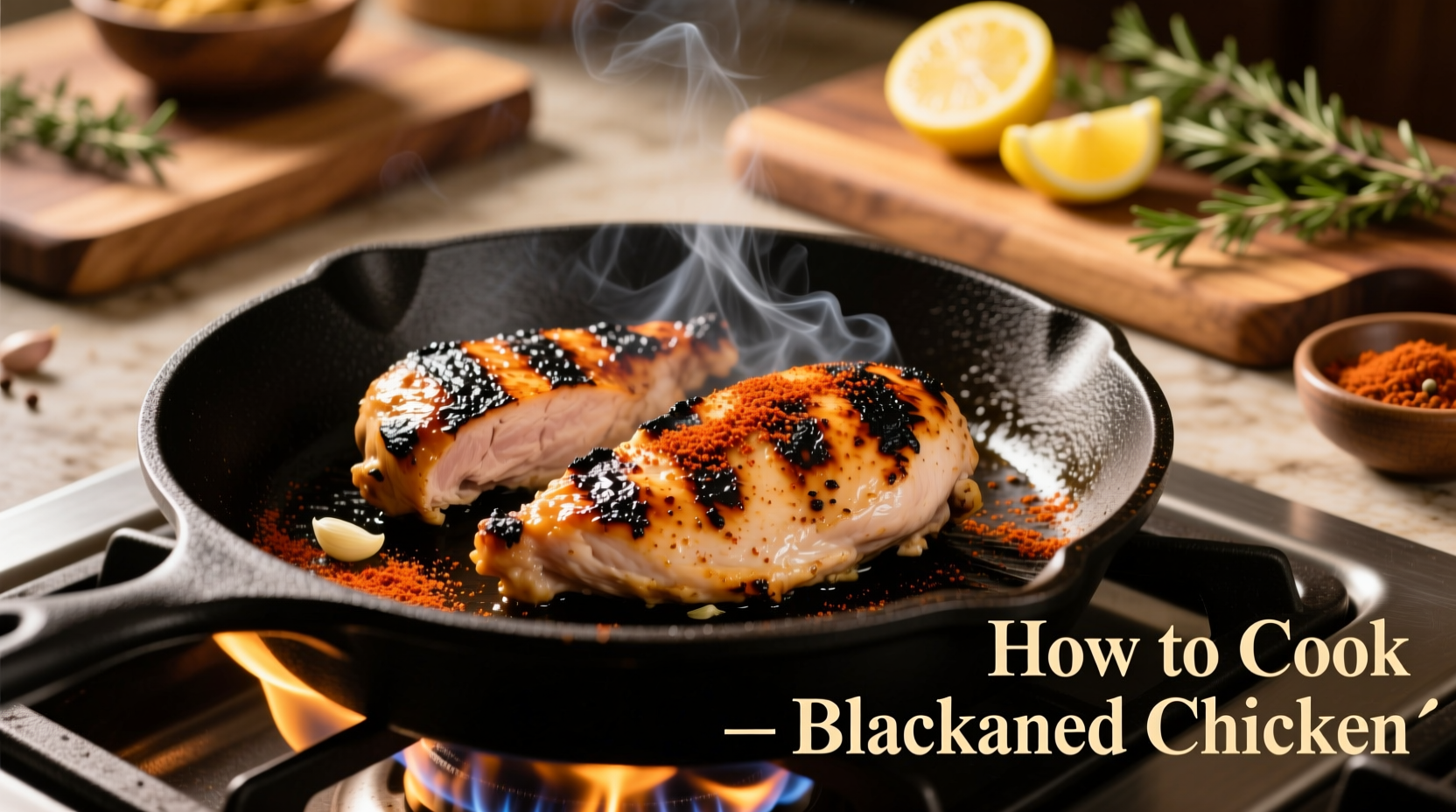Master the art of blackened chicken with this definitive guide that transforms your weeknight dinners. Forget dry, flavorless results—learn the professional technique that creates a flavorful crust while keeping the chicken tender and juicy. Whether you're a beginner or experienced cook, these actionable steps guarantee restaurant-quality blackened chicken every time.
What Makes Blackened Chicken Different From Other Cooking Methods
Blackened chicken isn't just spicy grilled chicken—it's a specific cooking technique developed by Chef Paul Prudhomme in the 1980s that creates a distinctive charred crust through high-heat cooking with a spice rub. Unlike grilled or pan-seared chicken, the blackening process involves:
| Cooking Method | Temperature | Spice Application | Resulting Texture |
|---|---|---|---|
| Blackening | 500°F+ (smoking hot) | Generous dry rub before cooking | Charred crust, juicy interior |
| Pan-Searing | 375-400°F | Seasoning during cooking | Browned exterior, firm texture |
| Grilling | 350-450°F | Applied before or during cooking | Char marks, slightly drier texture |
The Evolution of Blackened Chicken Technique
Understanding the history helps perfect your technique. Blackened chicken emerged from Louisiana's culinary traditions:
- 1980: Chef Paul Prudhomme popularizes blackening technique at Commander's Palace in New Orleans using cast-iron skillets
- 1983: Blackened redfish becomes a national phenomenon, inspiring adaptation to chicken
- 1990s: Home cooks adopt the technique but often struggle with smoke control and proper heat management
- Present: Modern adaptations include indoor smoke management techniques and spice blend variations
Essential Equipment Checklist
You don't need specialty tools, but these items make the process successful:
- Cast-iron skillet (10-12 inches) - essential for even heat distribution
- Instant-read thermometer (critical for food safety)
- Heavy-duty tongs for flipping without losing juices
- Spice shaker or small bowl for even rub application
- Range hood or ventilation system (blackening creates significant smoke)

Perfect Blackened Chicken Spice Rub Formula
This authentic blend creates complex flavor without overwhelming heat. Make extra to keep in your spice cabinet:
- 2 tablespoons smoked paprika (provides depth without burning)
- 1 tablespoon garlic powder (never fresh garlic, which burns)
- 1 tablespoon dried thyme (essential for herbal notes)
- 2 teaspoons cayenne pepper (adjust to heat preference)
- 1 teaspoon onion powder
- 1 teaspoon dried oregano
- 1 teaspoon black pepper
- 1 teaspoon salt
- 1/2 teaspoon cumin (optional for earthy notes)
According to the James Beard Foundation's culinary archives, the proper spice-to-chicken ratio is crucial—use 1 tablespoon of rub per 6-ounce chicken breast for optimal flavor penetration without bitterness.
Step-by-Step Cooking Process
Follow these precise steps for perfect blackened chicken every time:
Preparation Phase (5 minutes)
- Pat chicken completely dry with paper towels (moisture prevents proper blackening)
- Mix spice rub thoroughly in small bowl
- Coat chicken generously on both sides, pressing rub into surface
- Let rest 10 minutes at room temperature (critical for even cooking)
Cooking Phase (12-15 minutes)
- Preheat cast-iron skillet on high for 5 minutes until smoking hot
- Add 1 teaspoon oil with high smoke point (avocado or grapeseed)
- Place chicken in skillet away from you to avoid oil splatter
- Cook 6-8 minutes without moving until deep brown crust forms
- Flip and cook 5-7 minutes until internal temperature reaches 165°F
- Rest 5 minutes before slicing to retain juices
Avoid These Common Blackened Chicken Mistakes
Professional chefs consistently avoid these pitfalls that ruin home attempts:
- Mistake: Using wet chicken
Solution: Always pat chicken bone-dry—moisture creates steam instead of char - Mistake: Skillet not hot enough
Solution: Heat until oil smokes lightly before adding chicken - Mistake: Moving chicken too soon
Solution: Wait until it releases naturally from the pan - Mistake: Overcrowding the pan
Solution: Cook in batches with space between pieces
When Blackened Chicken Works Best (And When to Choose Alternatives)
Understanding context boundaries improves your cooking decisions:
- Ideal for: Quick weeknight dinners, outdoor entertaining, when you want bold flavor without marinating time
- Avoid when: Cooking for young children or heat-sensitive guests, in small kitchens with poor ventilation, during hot summer months
- Better alternatives: For delicate flavors, try herb-roasted chicken; for indoor cooking with less smoke, use the broiler method with spice rub
Serving Suggestions That Elevate Your Dish
Pair your perfectly blackened chicken with these complementary sides:
- Cold cucumber salad with lemon vinaigrette (cuts the heat)
- Roasted sweet potatoes with honey glaze (balances smokiness)
- Creamy grits or polenta (traditional Southern pairing)
- Simple green salad with light vinaigrette
For the complete meal experience, the USDA Food Safety and Inspection Service recommends serving immediately after the 5-minute resting period to maintain food safety standards while preserving optimal texture.
Storage and Reheating Guidelines
Proper handling maintains quality if you have leftovers:
- Refrigerate within 2 hours of cooking in airtight container
- Consume within 3-4 days for best quality
- Reheat in oven at 325°F until internal temperature reaches 165°F
- Avoid microwaving, which makes the crust soggy
- Freeze uncooked seasoned chicken for up to 3 months











 浙公网安备
33010002000092号
浙公网安备
33010002000092号 浙B2-20120091-4
浙B2-20120091-4